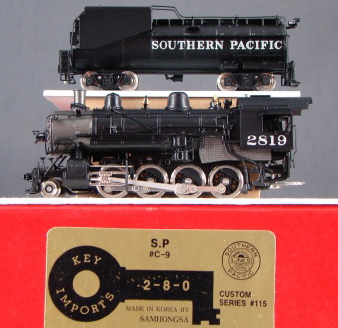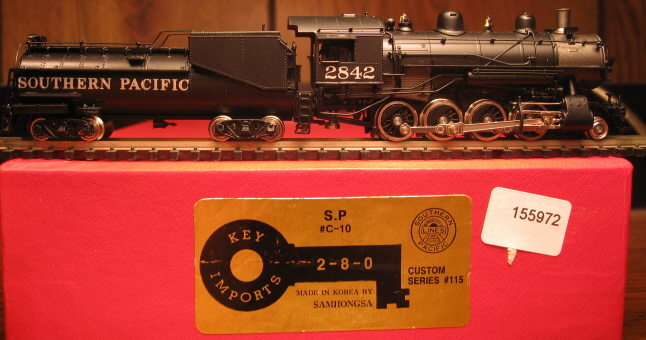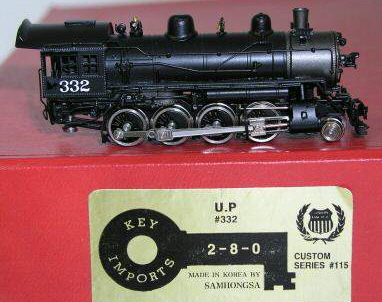UP #332



UP #332



Introduced: 1994
These 2-8-0 models (SP C-9, SP C-10 and UP #332) all came out at the same time (and all share the same Key serial number - SER #115), so I'm going to go ahead and assume they all share the same basic chassis/mechanism. Consequently, I'm going to review them all here based on the one C-10 I've actually purchased and tested.

The locomotive chassis is all-metal and fairly minimalistic (with most of the actual heft being provided by the shell). The motor is a small can job (no idea how many poles, but I'd assume three). The driveshaft consists of two short metal pieces and one long flexible plastic tube that links them together. Only one driver pair is geared (the second pair from the front). All the rest of the drivers are turned by the cranks. All gearing is metal. Right-rail pickup is provided by three of the right-side drivers, as well as the right pilot wheel. The front pair of drivers come with traction tires (a non-TT driver set is included in the box should you wish to trade more pickup for less pulling power). Left-rail pickup comes from the four left-side tender wheels. Current is conducted from the tender to the motor via two stiff wires firmly soldered to the drawbar (a nice improvement over the usual "one floppy wire" system normally found in old N scale steam). A non-directional headlight is wired to the motor and mounted inside the shell. The pilot coupler is a dummy (non-operational) knuckle. The tender has no coupler, although a MT-friendly pocket (with pre-drilled hole) is provided. Wheels are low-profile, so no problems on Code-55 rails.

These are fantastic looking models, and with performance to match. Mine runs extremely smoothly and quietly at almost all throttle levels. The only problem I noticed was a bit of cogging (herki-jerkiness) at the extreme low-end of the throttle (this most likely due to the 3-pole motor). But once you get going, slow-speed creep is excellent (although the top-end speed is quite excessive). The double-wired drawbar (along with the live pilot wheel) make for flawless pickup. I had no problems creeping through turnouts. I didn't experience any derailing issues or problems on narrow radius curves either. Overall, this is easily one of the best steamers I've ever run (brass or otherwise).
The one I purchased had been sitting in a box for well over a decade, so it did take a good 15-20 minutes of running around to wear the "crud" off the wheels. Also, I noticed a bit of a squeak (which turned out to be the tender wheels). A bit of a Conductalube on the axle points took care of that, though. Lastly, the drawbar wires might require a bit of tweaking to get optimal contact. I just bent mine slightly inwards to give them a tighter grip on the tender peg. And since mine has seen minimal running time, it's entirely possible that additional breaking-in (not to mention lubrication) will improve overall performance (particuarly at very slow speeds).

To remove the locomotive shell, first unscrew the screw underneath the pilot truck. Next, unscrew the two small screws on the back side of the cab. The shell should lift up and off at that point (just make sure you're lifting straight up - the motor is a tight squeeze through the chassis). To get at the headlight, unscrew the weight inside the shell and pull it out. This will free up the headlight wires and allow you to completely separate the chassis from the shell.
Grade: A